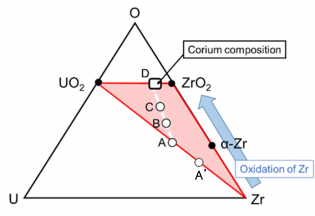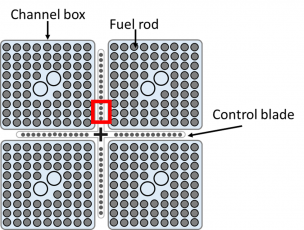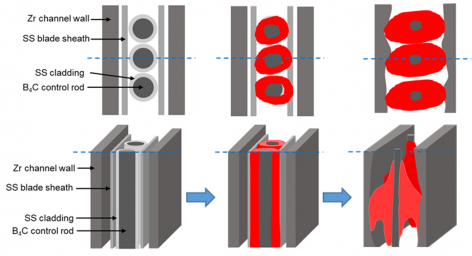「In-vesselでの燃料溶融および凝固」の版間の差分
Ohgi Hiroshi (トーク | 投稿記録) 編集の要約なし |
Ohgi Hiroshi (トーク | 投稿記録) 編集の要約なし |
||
| 55行目: | 55行目: | ||
(c) B4C-SSメルトとZry-4チャネルボックス間の相互作用 | (c) B4C-SSメルトとZry-4チャネルボックス間の相互作用 | ||
(d) B4C-SS-Zrメルトと残留B4Cの水蒸気酸化反応[[ファイル:Schematic image of liquefaction progression at the interface between the control blade and the channel box.png|サムネイル|472x472ピクセル|Figure 3(b) Schematic image of liquefaction progression at the interface between the control blade and the channel box.|代替文= | (d) B4C-SS-Zrメルトと残留B4Cの水蒸気酸化反応[[ファイル:Schematic image of liquefaction progression at the interface between the control blade and the channel box.png|サムネイル|472x472ピクセル|Figure 3(b) Schematic image of liquefaction progression at the interface between the control blade and the channel box.|代替文=]] | ||
2020年12月9日 (水) 15:17時点における版
In-vesselでの燃料溶融
a. Early phase
一般に、炉心現象の初期段階では、燃料温度の急激な上昇が起こり、炉心材料のリロケーションが開始します。 初期段階での燃料劣化を説明するために、以下の2つの液相化進展挙動が特に重要です。
1)燃料ペレット-ジルカロイ被覆管界面の液相化進展挙動
2)燃料集合体部材の液化進展挙動
燃料ペレット-ジルカロイ被覆管界面の液相化進展挙動
図X1に、温度上昇に伴うUO2燃料とジルカロイ被覆管(Zry)との界面近傍での相転移の概略図を示す[5]。左側は燃料ペレット、中央から右側はZry被覆管を示している。通常運転時では、冷却水が被覆管のすぐ外側を流れており、被覆管温度はおよそ300℃となる[1]。被覆管外周部は冷却水との相互作用によりZrO2層が形成される(その厚さは操作条件や照射時間によるが、約20μm程度となる[1])。 ZrO2層は酸素の拡散を防ぐ保護膜として機能するため、通常運転時にはα-Zr(O)相はほとんど形成されないと考えられている。
事故が発生すると、液状化は次の3つの段階に分けることができます。
酸素の拡散が支配的な温度範囲(約1800℃以下)
炉心への冷却水の供給が不足すると、冷却水の水位が低下し、炉心・燃料が水蒸気中に漏出する。これにより、燃料温度が上昇する。
温度が上昇すると、被覆管外周部では水蒸気酸化(水蒸気/Zr反応)により酸化物の二重層構造(ZrO2外層とα-Zr(O)内層)が形成され、約1200℃を超えると、水蒸気/Zry反応が急速に進み、温度の急上昇が起こる(毎秒8℃以上)[1]。被覆管の中央にはβ相が残留する。UO2燃料t/Zry界面では、酸素とウランがペレットからジルカロイ側に、Zrが燃料側に拡散を開始する。しかしながら、比較的低い温度(約1800℃以下)では酸素の拡散が支配的と考えられ、UとZrの拡散は界面近傍に限定される[2]。 酸素ポテンシャルが低下したUO2/Zry界面の非常に狭い領域(おそらくα-Zr(O)領域側)において、UO2とZrの間の酸化還元相互作用によって少量の液体が形成される可能性がある。その先に燃料からZryへの酸素拡散によるα-Zr(O)相が形成される。
(Hofmannの図にリンク)
- 水蒸気/Zr反応: Zr + 2H2O → ZrO2 + 2H2 (ΔH=-586 kJ/mol)
液相化が急速に進展する温度温度(約1800℃~2200℃)
約1800~2200℃の範囲では、複雑な反応が起こるが、全体的な傾向としては、U、Zr、Oの相互拡散が顕著になり界面反応が促進され、β-Zr相からα-Zr(O)相への変態およびU-Zr-Oメルト相の急速な拡大が生じる。このような相形成は、管束(バンドル)劣化試験でHofmannによって観察されています[7、8]。
熱力学的評価によると、被覆管の中央領域に残っているα-Zr(O)とβ-Zrは、1900〜2100°Cの温度範囲でU-Zr-Oメルト相として完全に液化すると考えられる (β相(酸素固溶飽和)の液化温度:約1950℃、α-Zr(O)相の液化温度:約2100℃、しかしながら、液化温度は 局所酸素含有量に依存する)。U-Zr-Oメルト相は、内側に残留するUO2と外側に残留するZrO2を溶融して成長するが、温度によってそれらの溶解度に制限がある[3]。
約2200℃までには、中央領域が完全に液化すると仮定すると、燃料棒は大きく3つの領域、すなわち、UO2/U-Zr-Oメルト/ZrO2の構造が形成されると考えられている[3]。
溶融した燃料の下方へのリロケーション(約2200℃以上)
Phebus-FPT試験[4]等の模擬試験での観測結果に基づき、約2200℃でU-Zr-Oメルトが燃料棒の外周から噴出し、炉心下方向にリロケーション開始すると考えられている[3]。シビアアクシデント解析コード(MAAP、MELCOR、ASTEC、SAMPSONなど)では、この温度が燃料溶融温度としてモデル化されている。また、ASTECコード等では、溶融物がZrO2膜を破って下方にリロケーションするか、あるいは、ZrO2膜の内側に維持されたまま、機械的に崩落するかについて、閾条件があるとされている。約2200℃に到達した際の外周のZrO2膜が約200~250μmより厚い場合、U-Zr-Oメルトはこれを破ることができず、燃料棒内部で保持され、なんらかの衝撃により、機械的に崩落すると考えられている。
参考文献:Phebusの論文。これ?PFT 0 - 5全部ある or 持ってる人いる?
燃料溶融進展にともなう溶融物の平均組成の変化
SA分析コードでは、一般に、α-Zr(O)とUO2の間のいわゆる「共晶」液状化モデルが実装されます。ただし、このモデルはSA分析用に指定された一種の簡略化されたモデルであるため、このモデルでは燃料棒の液化メカニズムを正確に説明できませんでした。基本的に、初期段階での燃料棒の液化の進行は、U-Zr-O三元状態図を使用して認識できます[8]。図2は、温度の上昇に伴う燃料棒の局所組成の変化を模式的に示しています。通常の操作では、平均組成はUO2-Zr線(通常はBWR燃料中のZrが豊富)の間のどこかにプロットされ、外面でのZrベース合金の酸化によってUO2-ZrO2線に向かって徐々にふるいにかけられます(A ⇒B⇒C⇒D)事故が進むにつれて。このモデルは、初期段階で燃料棒で起こっている化学反応が、UO2-ZrO2-Zr三元領域の相安定性に基づいて熱力学的に議論できることを示しています。この特定の地域では、蛍石(FCC)、面心正方晶(TET)、単斜晶、HCP、BCC、および液体の熱力学的データが必要です。 FCC、TET、および単斜晶相は本質的に酸化性固溶体であり、一方、HCPおよびBCC相は金属固溶体(合金)です。液相には、より複雑な熱力学的記述が必要です。比較的低温では、U-Zr-O溶融物が液体の主要な成分です(いわゆる「金属」溶融物)。金属溶融物の組成範囲は、温度の上昇とともに徐々に拡大しています。次に、高温(約2550°C以上)では、金属溶融物(U-Zr-O)と酸化溶融物(UO2-ZrO2)が互いに溶解する可能性があります。これには、U-Zr-Oシステムの液体の複雑な熱力学モデルが必要です。また、中間温度領域で形成される混和性ギャップには、より複雑な熱力学モデルが必要です。
亜化学量論のU-Zr-Oメルトが形成される。
燃料集合体部材の溶融
図3(a)に燃料棒、制御ブレードおよびチャネルボックスで構成される典型的なBWR燃料集合体の水平断面図を示す[9]。燃料集合体は、Zr基合金製のチャネルボックスに囲まれており、BWRの場合、Zrの量はPWRの量よりも多い(約2倍の量)ことに注意する必要がある。さらに、重要な特徴は、制御ブレードがチャネルボックスの外側に配置され、燃料棒から離れていることである。
図3(b)に制御ブレードとチャネルボックスの溶融進展の概略図を示す。相互作用の主なコンポーネントは、(1)B4C吸収材とステンレス鋼(SS-304)被覆管からなる制御棒、(2)SS-316で作られたブレードシース、および(3)Zry-4チャネルボックスである。温度の上昇に伴い、以下の(a)-(d)の反応が生じると考えられる:
(a)制御棒ブレード内のB4Cとステンレス(SS)間の相互作用
(b) チャネルボックスの表面の酸化、
(c) B4C-SSメルトとZry-4チャネルボックス間の相互作用
(d) B4C-SS-Zrメルトと残留B4Cの水蒸気酸化反応
b. Transient and late phases
図4(b1)-(b5)に、 transient and late phasesの典型的な5段階の概略図を示しています。
(b1)燃料溶融物の大規模なリロケーションを開始
(b2)リロケーションしたデブリによる炉心下部の水蒸気流の遮断
(b3)コリウムプールの形成
(b4)溶融物の下部プレナムへの二次リロケーション
(b5)下部プレナムにおける酸化および金属溶融物の液化および成層
(b1) 燃料溶融物の大規模なリロケーションを開始:
主に金属部品(制御棒ブレードやチャネルボックスなど)の主要な再配置が始まり、その後、再配置された溶融物によって冷却剤流路の部分的な閉塞が発生します。その後、U-Zr-Oメルトの下部ヘッドへの再配置が発生します。各反応は急激な温度変化を伴うため、熱力学的アプローチだけではこれらの複雑な反応を正確に理解するだけでは不十分です。ただし、事故シナリオに応じた反応傾向は、熱力学データベースによって評価できます。 FDNPS事故では、通常の事故シナリオとは異なる進行が発生する可能性があります(4.6章を参照)。熱力学データベースの改善/拡大は、これらの逸脱のいくつかの理由を示すことが期待されます。特に、初期のU-Zr-O溶融物は一般に酸化されますが、再配置段階では溶融物の組成がより複雑になるため、U-Zr-Oシステムの高温データベースの精度を向上させることが重要です。
(b2) Blockage of steam flow at lower part of the core by the relocated debris:
The blockage of the lower part of the core occurs by the collapsed oxide and metal debris. However, the BWR drainage scenario could occur in case of the insufficient blockage [16]. It is necessary to enhance accuracy of the U-Zr-Fe-O system data because the degree of blockage depends on the degree of oxidation of debris and the dissolution of the oxidized structural materials by the oxidic melt. As shown in chapter 4.5, the reaction between the U-Zr-O melt and Fe-oxide could proceed rapidly with local heat generation according to the thermodynamic analysis. This process could enhance the drainage scenario.
(b3) Formation of corium pool:
The melted and collapsed fuel is once cooled and re-solidified by the inhibition of the steam oxidation of Zr. After that, the temperature rises again by the decay heat, and this leads to the corium pool formation with a crust. The main components of corium are UO2-ZrO2 due to the oxidation progression of Zr. (However, in the case of the unit-2 of FDNPS, in which fuel melt could progress under the steam-served condition, the phase separation of oxidic and metallic melts could occur.) Therefore, the important system in this stage is also the U-Zr-O system.
(b4) Secondary relocation of corium melt to the lower plenum:
The corium pool is insulated by the surrounding crust layer and then it gradually expands. When the crust cannot support the corium weight with the corium extenuation, then the liquid corium can have secondary relocations to the lower plenum in a short period, either as rivulets or larger masses. The important database for this particular stage is U-Zr-Fe-O. However, the Fe-related databases are insufficient. The improvement is necessary. Besides, if the blockage by the crust layer is incomplete, it could lead to, not the corium pool growth, but the drainage scenario [16].
(b5) liquefaction and stratification of oxidic and metallic melt in the lower plenum:
In a typical accident scenario, the debris, which has fallen into the lower plenum and has cooled and solidified again on the lower plenum. Subsequent reheating and melting, could cause a stratification of the oxide and metal layers. In this scenario, the oxide melt is composed mainly of UO2-ZrO2-FeO, and mixed with the easily oxidized FP and presumably boron oxide. Metallic melts are mainly composed of SS-Zr-U, and mixed with metallic FP and B compounds. In some cases, the metal layer might be separated into heavy metal (U-Zr-rich) and light metal (Fe-rich) layers, according to MASCA results [17].
In such a multi-component system, it is difficult to evaluate its properties only by experiments, and conversely, it is effective to roughly evaluate the chemical state by the thermodynamic database [18]. Therefore, the accumulation of the experimental data and the improvement of thermodynamic databases and their joint evaluation for the multi-component system is continuously necessary.
Consequently, the base thermodynamic system for investigating these sequential reactions is U-Zr-SS-B4C-O. By considering the metallic corium and the oxidic corium separately, metallic corium can be evaluated by mainly Fe-Zr-X (X means U, Cr, Ni, B or C), and basically, it is important to enlarge the thermodynamic data already shown in the early phase section. On the other hand, the oxidic corium consists of mainly U-O-X and Zr-O-X (X means Fe, Cr, Ni, B or C). Table 19 shows the currently assessed status of U-O-X (see Table 18 as for the Zr-O-Fe system). The important systems are U-O-Zr, U-O-Fe and Zr-O-Fe. In the future, the enlargement of the U-Zr-Fe-O system will be an important issue for performing FDNPS debris analysis.
In-vessel debrisの凝固
In-vessel debrisの凝固説明文追記
二酸化物コリウムの凝固とU-Zr-Oの凝固が異なることの説明
In-Vessel debrisの凝固に関する熱力学解析 (凝固パス逆問題解析)
U-Zr-O系デブリの凝固パス解析1)亜量論U-Zr-Oメルトからの凝固
図5に
最高到達温度 約1900℃~約2550℃ 説明文追記 〇〇組成の液相が 急冷:〇相と〇相が検出される可能性 徐冷:〇相と〇相が検出される可能性
Case-2:UO2-ZrO2コリウムからの凝固
最高到達温度 約2550℃~ 説明文追記 〇〇組成の液相が 急冷:〇相と〇相が検出される可能性 徐冷:〇相と〇相が検出される可能性
- Example.jpg
キャプション1
- Example.jpg
キャプション2
Case-3:金属メルトからの凝固(現在解析中)
3-1) SS-B4C 最高到達 〇〇組成の液相が 急冷:〇相と〇相が検出される可能性 徐冷:〇相と〇相が検出される可能性
3-2) SS-B4C-Zr 〇〇組成の液相が 急冷:〇相と〇相が検出される可能性 徐冷:〇相と〇相が検出される可能性
- 凝固パス逆問題解析
実デブリサンプル中に同定された相により、デブリ最高到達温度、冷却状態(徐冷、急冷)および組成を評価することができる。 参考リンク
- ↑ 1.0 1.1 原子力安全協会(H10?),"軽水炉燃料のふるまい"
- ↑ P. Hofmann, D.K. Peck, "UO2/Zircaloy-4 chemical interactions from 1000 to 1700゚C under isothermal and transient temperature conditions", J. Nucl. Mat. 124, 80-105 (1984). https://doi.org/10.1016/0022-3115(84)90013-8
- ↑ 3.0 3.1 3.2 M.H.A. Piro, Advances in Nuclear Fuel Chemistry, Woodhead Publishing, 555-625, ISBN 9780081025710 (20202).
- ↑ B. Clément, N.H. Girault, G. Repetto, D. Jacquemain, A.V. Jones, M.P. Kissane, P. von der Hardt, "LWR severe accident simulation: synthesis of the results and interpretation of the first Phebus FP experiment FPT0", Nucl. Eng. Des. 226, 5-82 (2003). https://doi.org/10.1016/S0029-5493(03)00157-2




